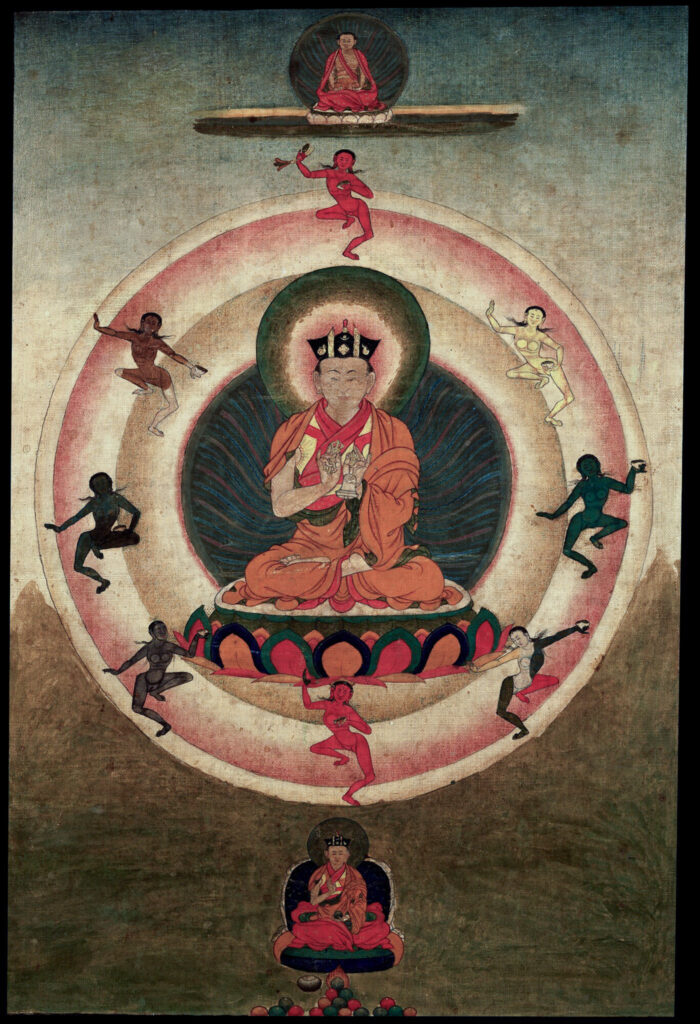THIS COURSE IS BEING RESCHEDULED. PLEASE CONTACT nbs_program_admin@nalandabodhi.org IF YOU WOULD LIKE TO BE EMAILED WHEN THE NEW DATES HAVE BEEN DETERMINED.
November 6, 13, 20 & December 4
6:00–7:30 pm PT
Zoom Only
Nalandabodhi Seattle is pleased to offer a new series of four classes on the history of the Karmapas. “Karmapa” means “the one who performs the activity of a Buddha.” Beginning in the year 1110, seventeen persons were born in succession in Tibet, each of whom earned the title “Karmapa.”
During the times of the Sixth Karmapa (1416-53) through Tenth Karmapa (1604-74), the Karma Kagyu (the lineage led by the Karmapas, also called the Karma Kamtsang) flourished in Tibet. Under the guidance of the Karmapas, the Kamtsang developed its own specific teaching systems. Similarly, the other great Tibetan lineages flourished and fashioned their own distinctive approaches to the teachings.
To begin to understand this historical time, this series will look at the Buddhist teachings inherited from India and how the Karmapas fashioned them into the Karma Kagyu’s distinctive system of Buddhist view and meditation. Rather than solely focus on individual Karmapas, we will look at the continuities in the teachings between Karmapas and with the Buddhist traditions of India.
The back story: From the seventh century onward, the two great traditions of mature Indian scholastic Buddhism, the Madhyamaka and Yogachara, had taken root and grown on Tibetan soil. But the adoption and adaptation of these Buddhist views and meditations did not happen in a vacuum – Buddhism mixed with the various social and political institutions already present in Tibet. Tibetans vigorously adapted the great Buddhist traditions of India. Distinct communities naturally formed around them.
During the lifetimes of the Fourth (1340-1383) and Fifth Karmapas (1384-1415), The Mongols’ imperial grip began to wane and Tibetans gradually gained their independence from the Empire. The new freedom from the dominance of the Mongol Empire helped usher in the “classical period” of Tibetan culture where Tibetans consolidated the teachings they had received. Tibetans rapidly developed their own distinctive social and religious organizations that, as aligned with different scholastic lineages, became central to the identities of Tibetans.
In the upcoming series, we will begin looking at Tibet after the Mongol Empire. We will recapitulate the activity of the Karmapas covered in the first two series, so attendance in this third series does not depend on prior classes. Once again, Martin Marvet has generously offered to share his research, knowledge and interest in the roots of the Karma Kagyu lineage. As with previous classes, this account of the activities of the early Karmapas takes place within the historical panorama of Tibetan society writ large, and offers particular insight into the development of the “tulku” system, a tradition unique to Tibetan Buddhism.
Recordings
Registration Details
Please check your email for the auto-confirmation after registering [subject: Registration Confirmation: The Karmapas (Thursdays, Nov 6-Dec 4, 6:00–7:30p)]
Questions:?
Teacher Bio
 Martin Marvet has been a student of Dzogchen Ponlop Rinpoche for decades. Since Karmapa Orgyen Thrinley Dorje’s arrival in Dharamsala in 2000, Martin has worked closely under Dzogchen Ponlop Rinpoche’s guidance to support Karmapa’s role in the West and was one of the lead co-ordinators for Karmapa’s visits to the U.S. in 2008, 2011, 2015 and 2017. This role engendered a life-long interest in research into the history of the Karmapas. As attorney and administrator, Martin supported Rinpoche in the legal formation and management of Nitartha International since 1992, Nalandabodhi since 1997, and Karmapa Foundation U.S. since 2007, as well as the acquisition, development and management of Nalanda West since 2003. Martin was a lawyer in private practice in New York prior to moving to Seattle in 1999 to help develop the Office of Dzogchen Ponlop Rinpoche.
Martin Marvet has been a student of Dzogchen Ponlop Rinpoche for decades. Since Karmapa Orgyen Thrinley Dorje’s arrival in Dharamsala in 2000, Martin has worked closely under Dzogchen Ponlop Rinpoche’s guidance to support Karmapa’s role in the West and was one of the lead co-ordinators for Karmapa’s visits to the U.S. in 2008, 2011, 2015 and 2017. This role engendered a life-long interest in research into the history of the Karmapas. As attorney and administrator, Martin supported Rinpoche in the legal formation and management of Nitartha International since 1992, Nalandabodhi since 1997, and Karmapa Foundation U.S. since 2007, as well as the acquisition, development and management of Nalanda West since 2003. Martin was a lawyer in private practice in New York prior to moving to Seattle in 1999 to help develop the Office of Dzogchen Ponlop Rinpoche.




